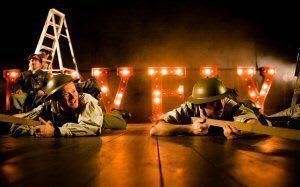I have a great affection for Oh What a Lovely War: it was one of the earliest shows I ever directed (and the first with music) back in, I think, 1972, so I approached Northern Stage's production with some trepidation. Even in 1972 it was dealing with history: would it have any effect at all today?
I needn't have worried. Indeed, it feels more relevant today, after the Falklands, two Gulf Wars and Afghanistan, than it did then. Perhaps nowadays we don't have to concern ourselves with uncaring military commanders (our population is bigger than theirs and we're killing more of them, so we'll win in the end, says General Haig at one point) but rather with uncaring politicians, but it's the thought that counts and we can replace Haig in our minds with any one of a number of politians from Thatcher on.
Good news, then. But the even better news is that directors Erica Whyman and Sam Kenyon have enhanced that relevance by judicious and clever updating.
What? Updating? But this is about the First World War: how can you update it? Well, of course you can't update the content but you can update the frame. The original production set it within the context of the end of the pier Pierrot show, a form that, in 1963 when it was first produced, was still within living memory although long out of favour. What the Northern Stage directors have done is update the frame, giving us a bunch of actor-musicans who also happen to be comedians. And it works, as does Kenyon's setting of the songs which, although retaining the melodies, updates the accompaniment. Add to that the fact that all the music is produced on stage by the actors, as in, for example, Return to the Forbidden Planet or any of the numerous musicals that have come from Newbury's Watermill, and the modernisation is complete.
The full width of the stage is used, the bare back wall provides the screen for the projections which form an integral part of the piece, and the only furniture is some chairs, some ladders, some boxes and the instruments (including a piano). My only caveat is that, at one point, the word "Lovely" outlined in bulbs flies in and sinks to the stage floor: it looks good but I'm not sure it added anything - but in the ocntext of the show as a whole, that's a minor quibble. Costumes are, apart from the various military caps, helmets and so on, and some coats, plain and in dark tones, with grey predominating. All very modern, and all very effective.
And was I the only one who felt a sense of a monochrome Godspell? Perhaps: my mind works in peculiar ways sometimes.
But, of course, without the right performers no set or costume excellence can make a production a success and Whyman and Kenyon have been blessed with a flawless cast whose energy and inventiveness are boundless, who work as a real team and who - most importantly - can move the audience from laughter to sadness at the drop (or change) of a hat. They are very comfortable in their roles so that even their ad-libbing (and a fair amount of that goes on) is totally in character and, even more vital, in the mood of the moment.
It would be invidious to single out any individual for special mention so, even though I did have my favourite moments, I won't do so. Suffice it to say that they are a true ensemble.
So: no disappointment. On the contrary, an enjoyable night which is by turns very funny and very moving. I have always found the song "And when they ask us" with its wry humour almost unbearably sad, and so it was again. It stayed in my head as I drove home afterwards: sadness and humour so closely knit together that they are inseparable, just like the show.
Playing until 27th March
